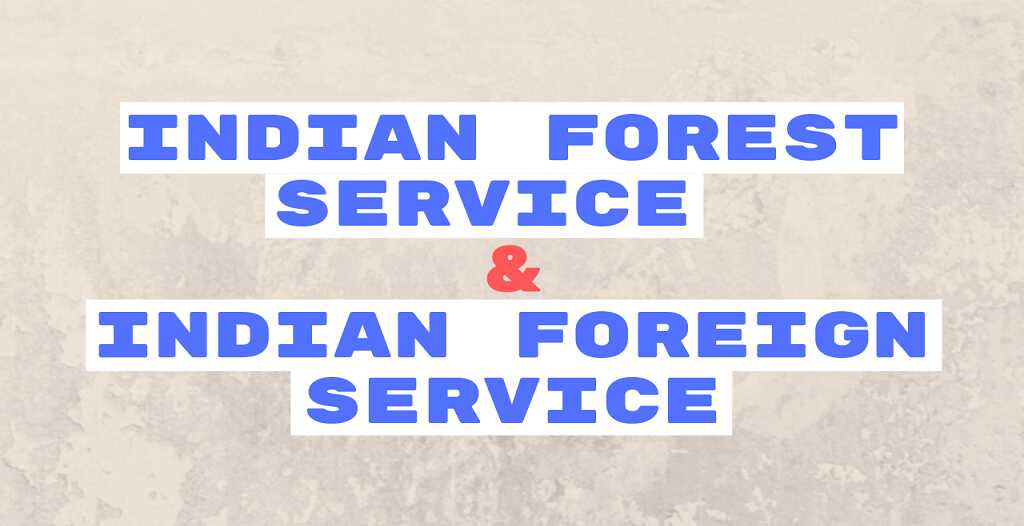The initials are the same for Indian Foreign Service and Indian Forest Service and recruitment into both these are done via the yearly examinations conducted by the union public service commission but both the roles are fundamentally different. Let’s take a look at their similarities and differences.
What is Indian Foreign Service?
IFS is the administrative diplomatic civil service under Group A and Group B of the Central Civil Services of the executive branch of the Government of India. It is a Central Civil Service since foreign policy is the subject matter and prerogative of the Union Government.
The Ambassador, High Commissioner, Consul General, Permanent Representative of India to the United Nations and Foreign Secretary are some of the offices held by the members of this profile.
How is an Indian Foreign Service Officer Recruited?
The Civil Services Examination is used for recruitment for the IFS. The entire selection process lasts for about 12 months. To be selected as an IFS officer, you need a topper’s rank as the most important eligibility criteria. Indian Foreign Service recruitment in recent years has done 16 to 20 recruits per year.
The present strength of the office stands at approximately 800 officers manning around 183 Indian missions and posts abroad and the various posts in the Ministry at Home (Defense, Finance, Home, etc.)
Also Read: What are Endogenic and Exogenic Forces? IAS Geography Notes
Training of an IFS Officer
New entrants to the role undergo significant training that is considered to be one of the most challenging and longest trainings in the Government of India and spanning almost 3 years.
Training begins at the Lal Bahadur Shastri National Academy of Administration (LBSNAA) in Mussoorie, where members of many elite Indian civil services are trained. After completing a 15-week training at the LBSNAA, the probationers join the Foreign Service Institute in New Delhi for more intensive training in a host of subjects important to diplomacy, including international relations theory, military diplomacy, trade, India’s foreign policy, history, international law, diplomatic practice, hospitality, protocol and administration.
They also go on attachments with different government bodies and defence (Army, Navy, Air Force, CAPF) establishments and undertake tours both in India and abroad. The entire training programme lasts for a period of 36 months.
Compulsory Foreign Language
Upon the completion of the training programme at the Institute, the officer is assigned a compulsory foreign language (CFL). After a brief period of desk attachment in the Ministry of External Affairs, at the rank of Assistant Secretary, the officer is posted to an Indian diplomatic mission abroad where her/ his CFL is the native language.
There the officer undergoes language training and is expected to develop proficiency in the CFL and pass an examination before being allowed to continue in the role.
Functions of Indian Foreign Service Officers:
The role is entrusted to conduct diplomacy and manage foreign relations of India. It is the body of career diplomats serving in more than 162 Indian Diplomatic Missions and International Organisations around the world. Besides, they serve at the headquarters of the Ministry of External Affairs in Delhi and the Prime Minister’s Office.
They also head the Regional Passport Offices throughout the country and hold positions in the President’s Secretariat and several ministries on deputation. Foreign Secretary of India is the administrative head of the Indian Foreign Service.
As a career diplomat, the Foreign Service Officer is required to project India’s interests, both at home and abroad on a wide variety of issues. These include bilateral political and economic cooperation, trade and investment promotion, cultural interaction, press and media liaison as well as a whole host of multilateral issues.
The Functions of an Indian Diplomat can be Summarized as:
- Representing India in his/ her Embassies, High Commissions, Consulates, and Permanent Missions to multilateral organizations like the UN.
- Protecting India’s national interests in the country of his/ her posting.
- Promoting friendly relations with the receiving state as also its people, including NRI/ PIOs.
- Reporting accurately on developments in the country of posting which are likely to influence the formulation of India’s policies.
- Negotiating agreements on various issues with the authorities of the receiving state.
- Extending consular facilities to foreigners and Indian nationals abroad.
The Ministry of External Affairs is responsible for all aspects of external relations. Territorial divisions deal with bilateral political and economic work while functional divisions look after policy planning, multilateral organizations, regional groupings, legal matters, disarmament, protocol, consular, Indian diaspora, press and publicity, administration and other aspects.
What is Indian Forest Service?
The Indian Forest Service is one of the three All India Services of the Government of India. The other two All India Services being the IAS and IPS. It was constituted in the year 1966 under the All India Services Act, 1951, by the Government of India.
How are Indian Forest Service Officers Recruited?
Officers are recruited via an open competitive Indian forest service examination conducted by the union public service commission.
Training of an Indian Forest Service Officer
On acceptance to the Indian Forest Service , new entrants undergo a probationary period (and are referred to as Officer Trainees). Training begins at the Lal Bahadur Shastri National Academy of Administration in Mussoorie, where members of many elite civil services are trained for 15 weeks.
On completion of which they go to the Indira Gandhi National Forest Academy at Dehradun, for more intensive training in a host of subjects important to Forestry, Wildlife Management, Biodiversity, Environment Protection, Climate Change, Forest Policies and Laws, Remote Sensing and GIS, Forest Dwellers and Scheduled Tribes.
After completion of their training, the officers are awarded a master’s degree in Science (Forestry) of Forest Research Institute. The officers are taught more than 56 subjects of life sciences in these two years.
Other Parts of the Training
They are also taught weapon handling, horse riding, motor vehicle training, swimming, forest and wildlife crime detection.
They also go on attachments with different government bodies and institutes such as Indian Military Academy, Sardar Vallabhbhai Patel National Police Academy, Wildlife Institute of India, Bombay Natural History Society etc. They also undertake extensive tours both in India and abroad.
After completing training at the academy, candidates go through a year of on-the-job field training in the state to which he or she is assigned, during which they are posted as Assistant Conservators of Forests/ Assistant Deputy Conservators of Forests or Deputy Conservator of Forests. After a total of four years of assistance in the junior scale including the professional training phase and foundation course, officers are appointed to the senior time scale and are entitled to be posted as Deputy Conservators of Forests/ Divisional Forest Officers (DFO) in charge of districts/ forest divisions.
Also Read: Understanding the Different Dimensions and Branches of Ethics: Ethics for UPSC
Function of an Indian Forest Service Officer
When an aspirant of the union public service commission successfully clears the Indian forest service exam and goes through the training period then he/ she becomes an officer.
The main mandate of the profile is the implementation of the National Forest Policy in order to ensure the ecological stability of the country through the protection and participatory sustainable management of natural resources.
Indian Forest Service officer is wholly independent of the district administration and exercises administrative, judicial and financial powers in his own domain. Positions in the state forest department, such as Divisional Forest Officer (DFO), Conservator of Forests (CF) and Principal Chief Conservator of Forests (PCCF) etc are held only by IFS officers. The highest-ranking IFS official in each state is the Head of Forest Forces.
The Ministry of Environment, Forest and Climate Change under the Government of India is the Cadre Controlling Authority of the Indian Forest Service.
Other Functions
The officers have the eligibility for State and Central deputations as their counterpart IAS and IPS officers. Deputation of Forest Service officers to the Central Government includes appointments in Central Ministries at the position of Deputy Secretary, Director, Joint Secretary and Additional Secretary etc.
Appointments in various Public Sector Units, Institutes and Academies at the position of Chief Vigilance Officer (CVO), Regional passport officers, Managing Directors, Inspector General, Director General etc.
Deputation of these officers is also permissible to foreign governments, United Nations bodies, international organisations, NGOs, voluntary organisations apart from the private sector as per the Indian Forest Service (Cadre) Rules, 1966.
Conclusion
Many union public service commission exam aspirants aim for these profiles and work very hard for achieving their goal. So which one is your targeting? Share your thoughts with us in the comment section below.
Also Read: IFS vs IAS: Which One is Better & Why? How to Become an IAS/ IFS Officer?






